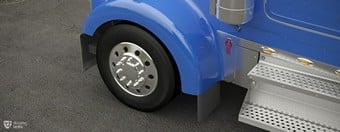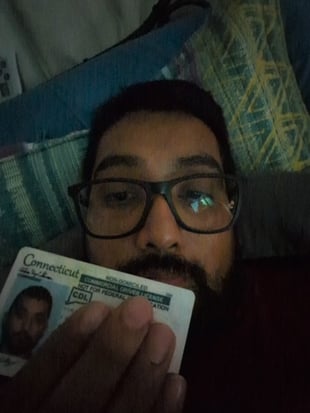

All your missed questions are saved
automatically for extra practice.




It's a practice test that's automatically made up of all your missed questions. Once you finish this test, you’ll be able to revisit your Challenge Bank™ to practice and sharpen your skills.
View All PlansAdding difficult questions to Challenge Bank™ is an exclusive Premium feature. Unlock access to 650+ exam-like questions, a Pass Guarantee, personalized study plans, and more.
View All PlansFree Connecticut CDL Permit Practice Test: General Knowledge 2025
We bet we know why you’re here: You need to pass the official General Knowledge test on commercial driving theory. You’ve been studying the official Connecticut Commercial Driver License Manual (Connecticut CDL Handbook 2025) because you know the knowledge test is based on it. But after you looked at the manual, you felt you could use some more help to be sure of passing the knowledge test. Great! That’s just what we do. We’ve helped thousands of aspiring drivers pass their knowledge tests, and we can help you too.
This free Connecticut CDL permit practice test is also based on the official manual and is up to date as of December, 2025. Practicing with it will reinforce your knowledge and identify topics you need to study further. Each of the 50 practice questions comes with a helpful hint and an explanation of the correct answer. The practice questions contained in this test will assess your knowledge of such topics as basic driving skills, cargo management, emergency preparedness, following distance, and pre-trip inspections. We have other General Knowledge practice tests on other topics too. Keep practicing with them until you feel ready to take the official General Knowledge test.
Passing the General Knowledge test is a big step – but only one step – toward obtaining a Commercial Driver’s License (CDL). By passing a medical examination and meeting a few other requirements, you’ll become eligible for a Commercial Learner’s Permit (CLP). It takes a lot of driving practice to become proficient at commercial driving. Your CLP will legally allow you to practice commercial driving under the supervision of a CDL holder. Once you become good at commercial driving, you will be ready to take the skills test for a CDL.
With your CDL in hand, you shouldn’t have trouble finding work as a commercial driver in Connecticut. The agricultural sector depends on truckers to transport its products. Manufacturing, largely in defense and aerospace, is the third-largest economic sector in the state. These high-tech firms depend on truckers to deliver equipment and materials to them as well as transport products. Another major economic sector in Connecticut is tourism, which employs bus drivers to transport visitors, especially to and from the state’s casinos.
The most important trucking route in Connecticut is Interstate 95, which runs along the coast between New York City and Rhode Island but which is notorious for traffic jams during rush hours. Other important commercial routes are Interstate 84, which connects Danbury to Hartford; and U.S. Route 7, which runs northward from Norwalk to Danbury and then to the Massachusetts border.


Authored and fact-checked by Steven Litvintchouk, M.S.
Chief Educational Researcher, Driving‑Tests.org (ACES member)
Last verified for accuracy on
Methodology & Editorial Policy
What to expect on the actual CT permit test
questions
correct answers to pass
passing score
Real Connecticut drivers who passed first try
Verified student reviews • Shared with permission

FAQs
What are the requirements?
To obtain a CDL in Connecticut, you need to get a commercial learner's permit (CLP) by passing knowledge tests. Hold the CLP for at least 14 days before taking the skills test. Additionally, you must meet age, medical, and residency requirements. CDL training, while not mandatory, is highly recommended for preparation.
What is the associated cost?
The cost for a CDL in Connecticut includes a $10 fee for the knowledge test and a $30 fee for the skills test. The CDL itself costs $70. Additional costs for training programs vary by provider.
How long does training last?
CDL training duration in Connecticut varies depending on the program. Full-time training typically lasts several weeks, while part-time training may take longer.
What is the minimum age required?
You must be at least 18 years old to obtain a CDL in Connecticut for intrastate driving. For interstate driving or to transport hazardous materials, you must be 21 years old.
What defines a commercial vehicle in the state?
In Connecticut, a commercial vehicle is defined as any motor vehicle used to transport goods or passengers for hire, with a Gross Vehicle Weight Rating (GVWR) of 26,001 pounds or more, designed to transport 16 or more passengers including the driver, or used to transport hazardous materials requiring placarding.
More CT CDL test resources
Are you in another state?
- Alabama
- Alaska
- Arizona
- Arkansas
- California
- Colorado
- Connecticut
- Delaware
- District of Columbia
- Florida
- Georgia
- Hawaii
- Idaho
- Illinois
- Indiana
- Iowa
- Kansas
- Kentucky
- Louisiana
- Maine
- Maryland
- Massachusetts
- Michigan
- Minnesota
- Mississippi
- Missouri
- Montana
- Nebraska
- Nevada
- New Hampshire
- New Jersey
- New Mexico
- New York
- North Carolina
- North Dakota
- Ohio
- Oklahoma
- Oregon
- Pennsylvania
- Rhode Island
- South Carolina
- South Dakota
- Tennessee
- Texas
- Utah
- Vermont
- Virginia
- Washington
- West Virginia
- Wisconsin
- Wyoming
We know what it takes to pass. And we’ve got the proof.
Driver’s Ed is - nobody wants to set foot inside the DMV. That’s why millions of learners trust us for simple, visual, effective prep.
An official & trusted partner in driver education
We are an officially recognized FMCSA Entry-Level Driver Training provider and a proud partner to over 2,500 libraries. We work with safety organizations like GHSA and the National Safety Council to help create safer roads for everyone.






A smarter way to study
Challenge Bank™
Our trademarked system automatically saves questions you miss, creating personalized tests that target your weak spots until you’ve mastered the material.
AI-powered feedback
Get smarter as you study. Our new AI-powered feedback provides detailed, question-level insights to help you understand the why behind each answer.
Interactive handbook
Go beyond the boring black-and-white manual. Our interactive handbook lets you read, listen with an MP3 audio version, or even chat with it to find the information you need, faster.
